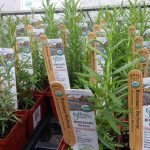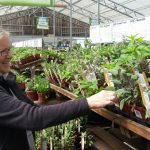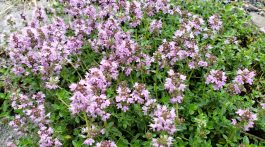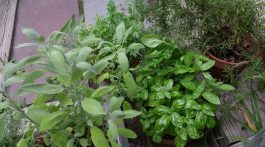“The most important thing about growing herbs is to put the plants close to the kitchen door,” said Carrie Gilbertie of Gilbertie’s Herb Gardens in Westport. I’d gone to her for herb-growing advice and was surprised at her answer. Yes, they need to be in a sunny spot, regularly watered, and fertilized from time to time, but, she suggested, “it’s no good if they’re far away from the cook.”
“Herbs like to be used,” she went on to say. Snipping off stems and leaves stimulates growth and strengthens the roots. Pruning by the cook adds flavor to the dish and vitality to the plant. A win – win!
We’ve had a few pots of herbs on our front steps for years, convenient for quick harvesting and sunny enough for the plants to flourish. The fresh herb flavors and satisfaction of using home-grown make the effort worthwhile.
 Like everything else, there are trends and fads in herbs as cooks widen their reach for new flavors. Thai Basil, Lemongrass, and Cilantro are rising in popularity, but year after year you can’t beat the Simon and Garfunkel mix: Parsley, Sage, Rosemary, and Thyme. In fact, those four have been the basis of my potted herb garden for years. I find the song running through my head as I clip the herbs.
Like everything else, there are trends and fads in herbs as cooks widen their reach for new flavors. Thai Basil, Lemongrass, and Cilantro are rising in popularity, but year after year you can’t beat the Simon and Garfunkel mix: Parsley, Sage, Rosemary, and Thyme. In fact, those four have been the basis of my potted herb garden for years. I find the song running through my head as I clip the herbs.
My parsley doesn’t seem to do very well. At Carrie’s suggestion, I’m giving it a pot of its own this year. It likes to be a little cooler and more moist than the others. Italian has more flavor than the better looking curly parsley, but it can get a little scraggly looking.
The sage thrives. It comes in a range of colors, sizes and shapes. Mine surprisingly survived outside over this past winter. I’m constantly on the lookout for recipes to use up its prolific output.
I’ve had the same rosemary plant for a few years now in a pot by itself, so I can bring it inside to a south-facing window for the winter. By spring it’s striving for sunlight and just barely hanging on – but it survives and provides some fresh cuttings for roast chicken during the cold months.
Thyme does well on my steps. It grows upright for cutting or lays flat as a filler between garden stepping stones. At Gilberties, there was a long lineup of varieties. “French has more flavor than the English,” Carrie said. “It’s better for cooking.” Taking a deep breath of the lemon thyme she declared it her favorite. I got both the a French and Lemon for this year’s pot.
For a cook, touring the herb greenhouse at Gilbertie’s is like being a kid in a candy store. Shelf after shelf of green, lush, fragrant potted herbs are lined up, ready to be adopted by eager culinary gardeners. The flavoring possibilities are limitless.
 The diversity is overwhelming. Not just some basil, there are at least twenty different varieties – bright green or dark purple, dwarf or oversized, decorative or practical. Sal Gilbertie, patriarch of the herb-growing family, chose a large-leafed variety to be labeled, “Sal’s Italian Choice.” Carrie confided that the standard Genovese is her go-to plant, best for making pesto and all-round culinary use. I took home two of Carrie’s and one of Sal’s for my front steps garden. We’ll see how the pesto turns out.
The diversity is overwhelming. Not just some basil, there are at least twenty different varieties – bright green or dark purple, dwarf or oversized, decorative or practical. Sal Gilbertie, patriarch of the herb-growing family, chose a large-leafed variety to be labeled, “Sal’s Italian Choice.” Carrie confided that the standard Genovese is her go-to plant, best for making pesto and all-round culinary use. I took home two of Carrie’s and one of Sal’s for my front steps garden. We’ll see how the pesto turns out.
 Rosemary is another category with lots of variety. Sal’s Choice here, originally from Israel, is a vigorous grower with great flavor. Barbecue is a rosemary variety with exceptionally strong stems, great for making herb skewers for the grill. Tuscan Blue is a fast grower sporting dark blue flowers.
Rosemary is another category with lots of variety. Sal’s Choice here, originally from Israel, is a vigorous grower with great flavor. Barbecue is a rosemary variety with exceptionally strong stems, great for making herb skewers for the grill. Tuscan Blue is a fast grower sporting dark blue flowers.
As you walk along the aisles less familiar names like lovage, lavender, and lemon balm will fire your imagination. Old friends like oregano, dill and mint (conjuring up juleps) are there, too.
Carrie gave me some tips for successful herb growing. When you’re planting in pots, make sure there is a hole in the bottom for drainage and maybe a layer stones, too, to keep the roots from being soggy. Let the pots dry out between watering, then water well so the soil is evenly moist. “I fill the pot to the rim and let the water soak in, do it again, and then a third time, until the water comes out the bottom of the pot,” Carrie explained. The plants like to be watered in the morning. Try not to get the leaves wet; the sun can burn through the lens of water drops.
 All Gilbertie’s herbs are organic, grown on their farm in Easton. To maintain the certification, use organic fertilizer at home. Granular slow-release fertilizer like Dr. Earth brand is preferred for steady feeding over water soluble types that can give a quick jolt of nutrients and then a roller-coaster ride of feast and famine.
All Gilbertie’s herbs are organic, grown on their farm in Easton. To maintain the certification, use organic fertilizer at home. Granular slow-release fertilizer like Dr. Earth brand is preferred for steady feeding over water soluble types that can give a quick jolt of nutrients and then a roller-coaster ride of feast and famine.
Frequent cutting is good for the plants. When you see them flowering, cut them back to promote vigorous new growth. If you’re driving on a summer getaway, think about taking your pots of low-maintenance herbs along. Beach or mountain, they’ll add flavor to vacation cooking too.
There was a big sign at Gilbertie’s, “Frost Free Day is May 15.” By now you’re safely able to pot your herbs and get them outdoors. In just a few weeks, you’ll be able to start snipping. Front steps to table, it doesn’t get any fresher!















No Comment